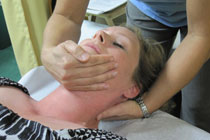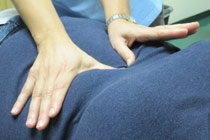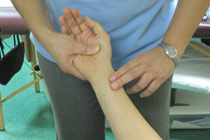Tui Na (Chinese Massage)
The History of Tui Na
 Tui Na, "the oldest known system of massage and physical therapy in the world" (Chi Wellness Clinic), can be traced back to the Shang Dynasty of ancient China, 1700 B.C.E. (Traditional Chinese Medicine & Acupuncture). Bones were found documenting the fact that Tui Na was used to treat children's diseases and adults' digestive problems (Traditional Chinese Medicine (TCM) & Acupuncture). Later a Chinese medical book called The Yellow Emperor's Classic of Internal Medicine, written about 2,500 years ago, documented detailed Tui Na techniques (Acupuncture Today).
Tui Na, "the oldest known system of massage and physical therapy in the world" (Chi Wellness Clinic), can be traced back to the Shang Dynasty of ancient China, 1700 B.C.E. (Traditional Chinese Medicine & Acupuncture). Bones were found documenting the fact that Tui Na was used to treat children's diseases and adults' digestive problems (Traditional Chinese Medicine (TCM) & Acupuncture). Later a Chinese medical book called The Yellow Emperor's Classic of Internal Medicine, written about 2,500 years ago, documented detailed Tui Na techniques (Acupuncture Today).
Since then, Tui Na has gradually gained its popularity and recognition among the Chinese public (Acupuncture Today). By the 6th century, a great number of traditional Chinese medical schools had separated Tui Na from other styles of massage as an independent course for students to learn (Acupuncture Today). Now Tui Na is taught in major medical schools in China "as a separate but equal field of study"(Acupuncture Today).
 Tui Na was originally introduced to the United States by Share K. Lew in 1975, when he started to teach some techniques of Tui Na (The Taoist Sanctuary of San Diego). In the early 1980s Bob and Honora Flaws began Tui Na training groups in China (The Taoist Sanctuary of San Diego). Since then, Tui Na has been a part of the curriculum of oriental medical schools and massage schools in the United States. It's regarded as "a powerful therapeutic extension of traditional western massage methods" (The Taoist Sanctuary of San Diego). It's also taught at every ACAOM-accredited school in the United States as a required curriculum (Acupuncture Today).
Tui Na was originally introduced to the United States by Share K. Lew in 1975, when he started to teach some techniques of Tui Na (The Taoist Sanctuary of San Diego). In the early 1980s Bob and Honora Flaws began Tui Na training groups in China (The Taoist Sanctuary of San Diego). Since then, Tui Na has been a part of the curriculum of oriental medical schools and massage schools in the United States. It's regarded as "a powerful therapeutic extension of traditional western massage methods" (The Taoist Sanctuary of San Diego). It's also taught at every ACAOM-accredited school in the United States as a required curriculum (Acupuncture Today).
What Is Tui Na?
Tui Na is a style of Asian bodywork which uses "various strokes, shaking, stretching, and joint movements" along energy channels to balance the body's energy, as well as physical and emotional systems (Henderson).Tui Na bases its therapeutic orientation on "the Traditional Chinese Medical theory of channels and collaterals (meridians or pathways)" and the flow of Qi (energy) (The Taoist Sanctuary of San Diego).
Health Benefits
 Tui Na provides all the benefits of traditional western massage such as enhanced circulation, respiration and digestion. It also works well for specific health concerns (Henderson; The World Tui-Na Association). It's especially effective for chronic pain in muscles, joints, and skeletal system working well for arthritis, sciatica, and muscle spasms (Henderson). It can also improve chronic conditions such as insomnia, constipation, and migraines (Henderson).
Tui Na provides all the benefits of traditional western massage such as enhanced circulation, respiration and digestion. It also works well for specific health concerns (Henderson; The World Tui-Na Association). It's especially effective for chronic pain in muscles, joints, and skeletal system working well for arthritis, sciatica, and muscle spasms (Henderson). It can also improve chronic conditions such as insomnia, constipation, and migraines (Henderson).
By improving and restoring the flow of qi (energy) in the body, Tui Na promotes self-healing and creates a sense of general well-being both physically and mentally (Henderson; Acupuncture Today).
Dr. Xuguang Yang has 8 years of training in Traditional Chinese Medicine in China and has accumulated much clinical experience in major Chinese hospitals. Since 2001 he has been teaching Tui Na, acupuncture and Chinese Medicine in various locations in the United States. Now he also owns a successful business called "Dr.Yang Acupuncture & Traditional Chinese Medicine" in Gainesville, Florida, practicing acupuncture and Tui Na. Here is his view of Tui Na:
